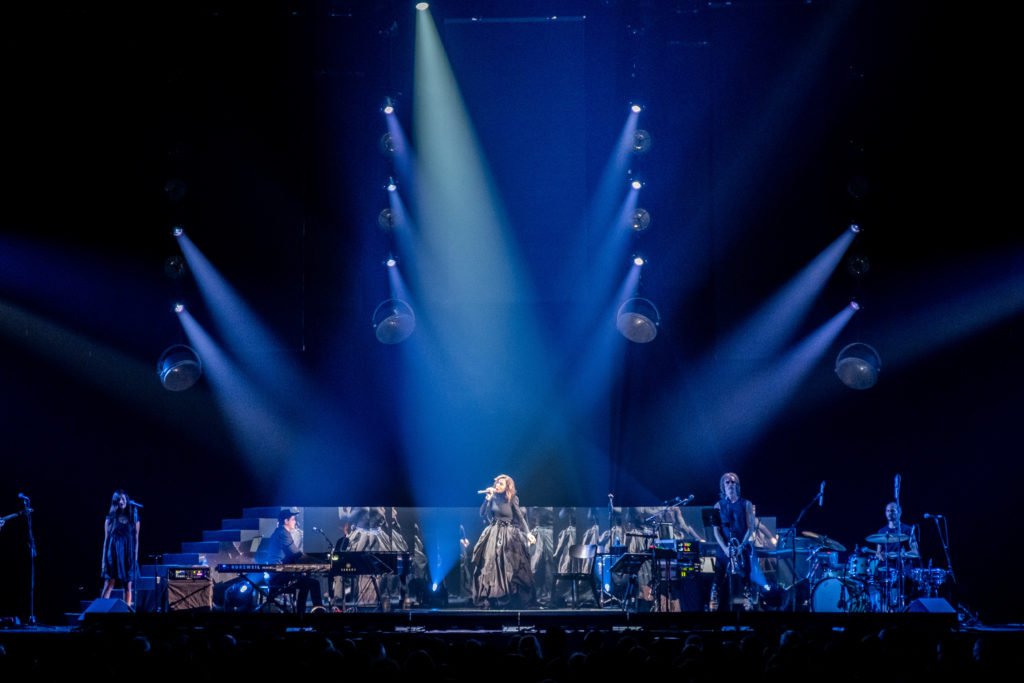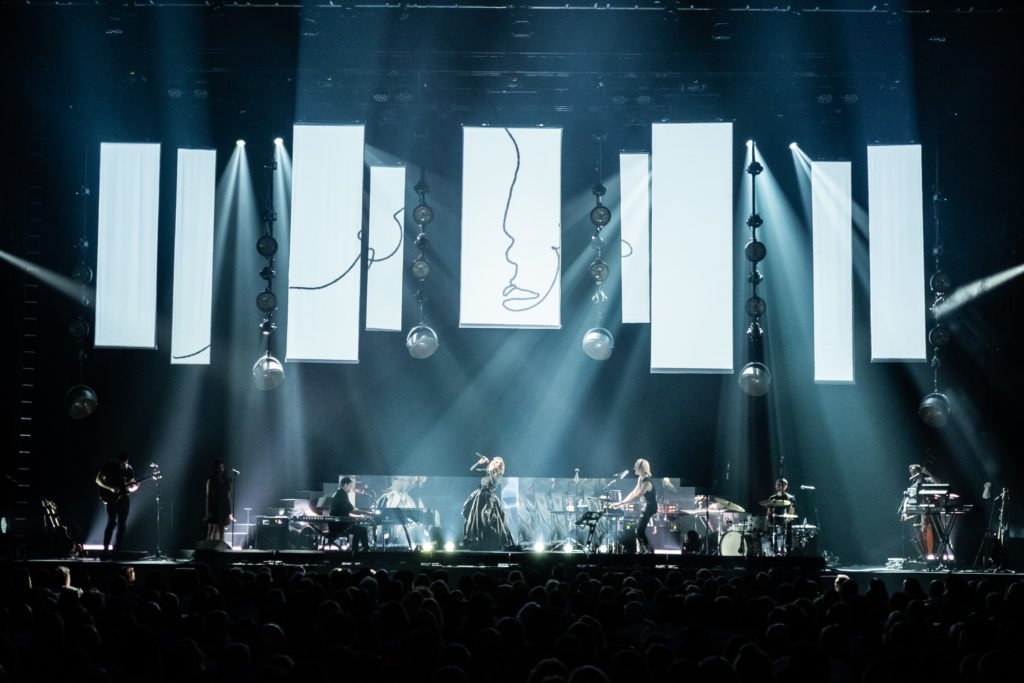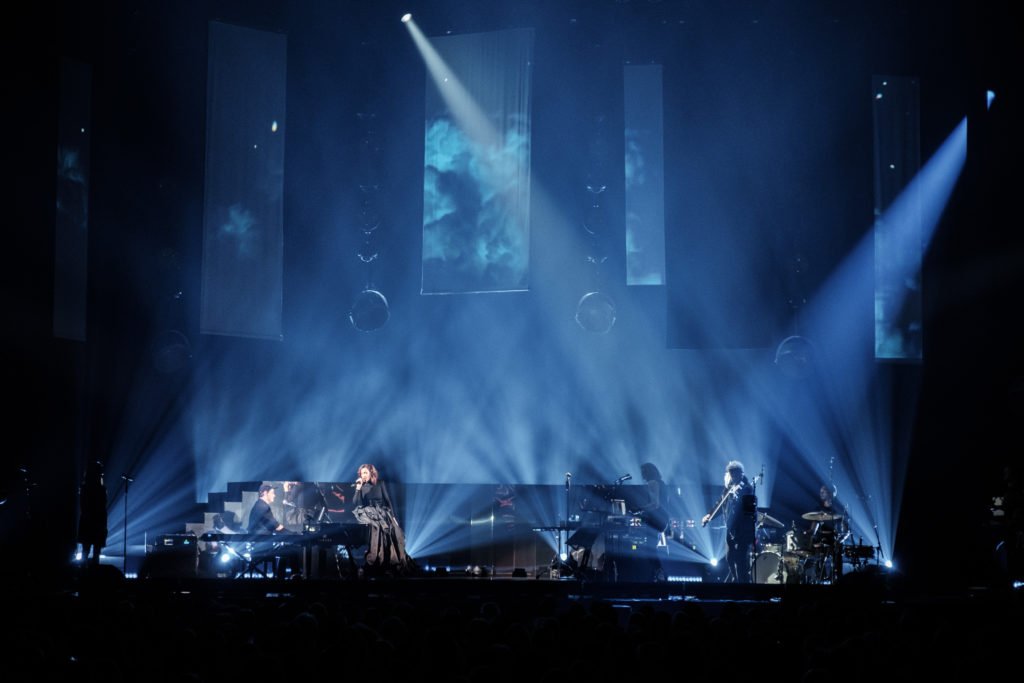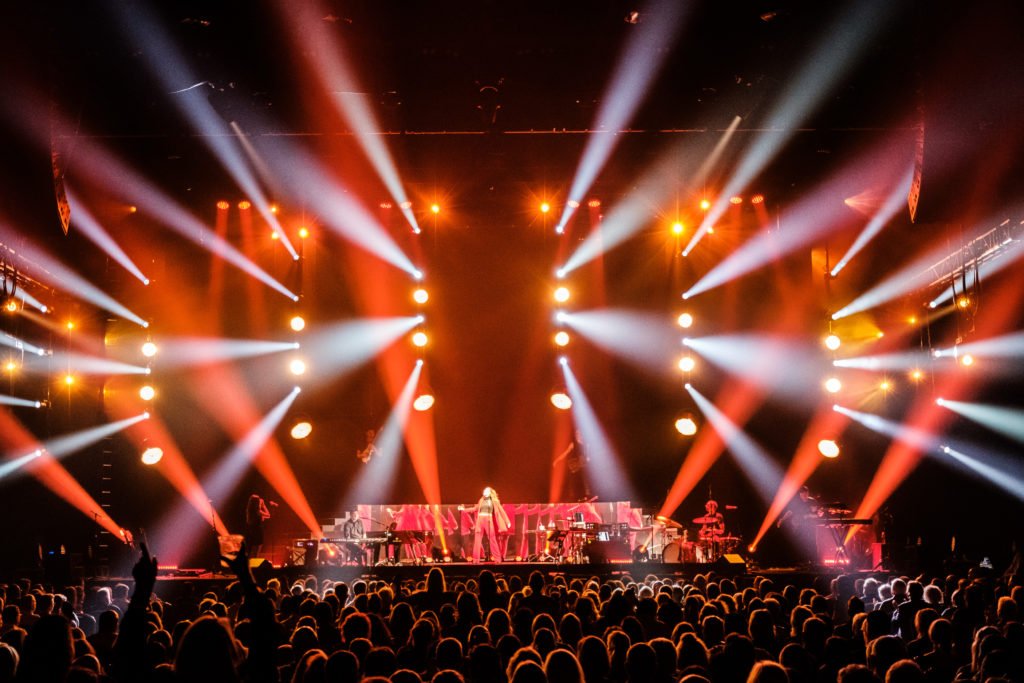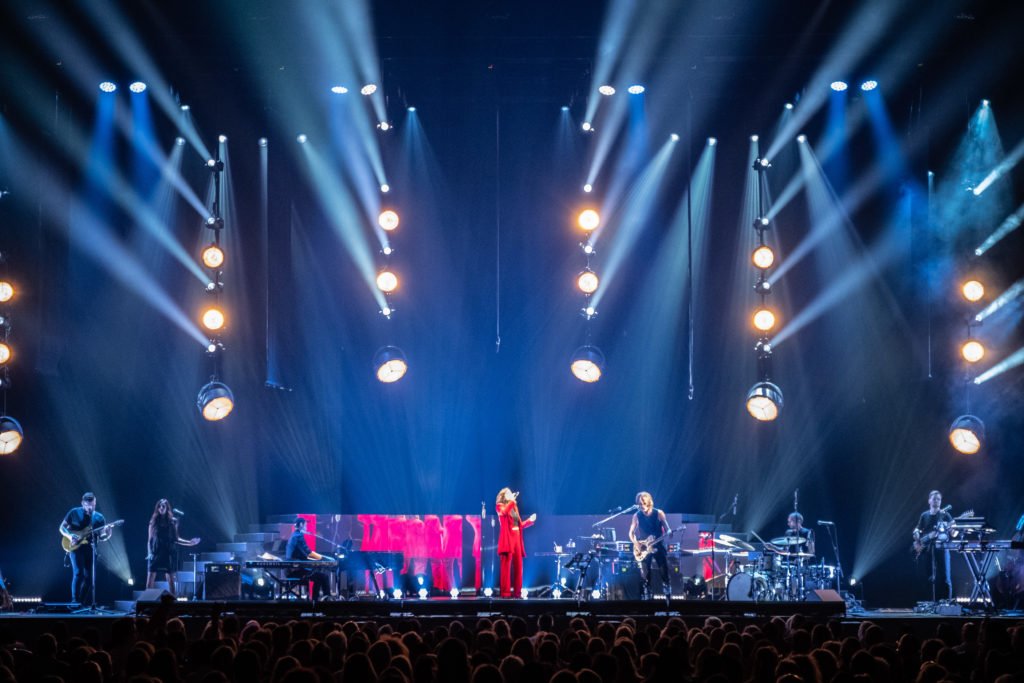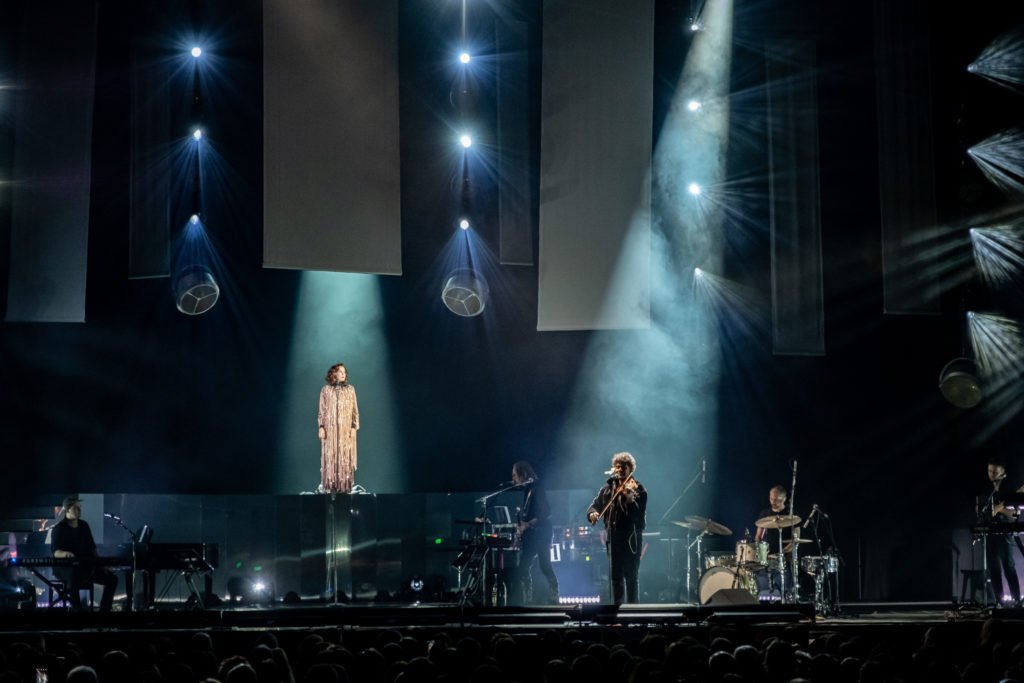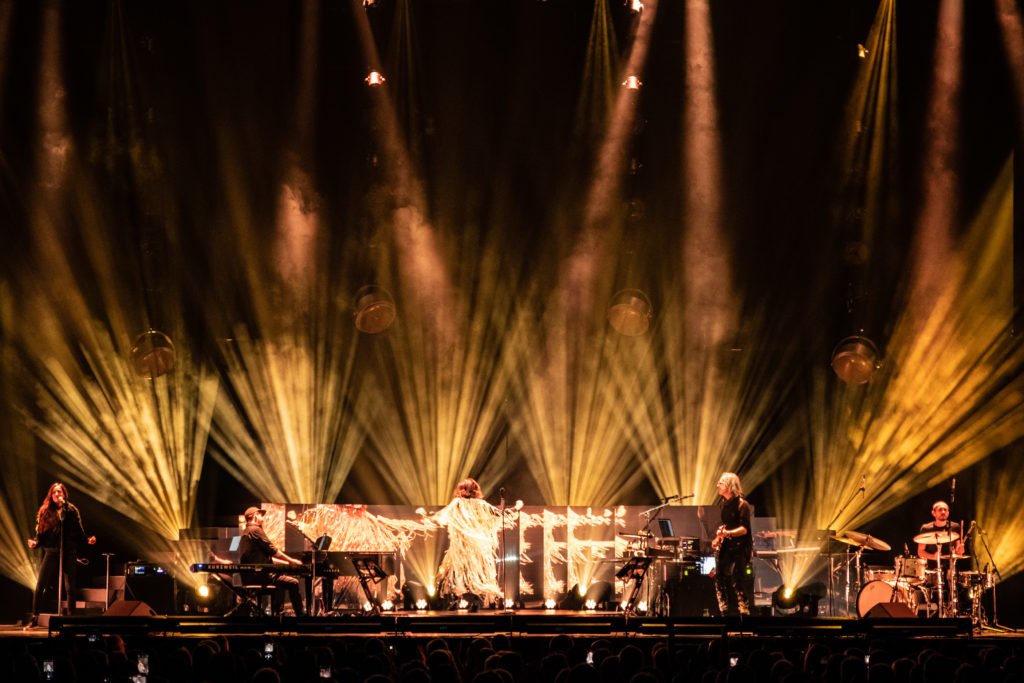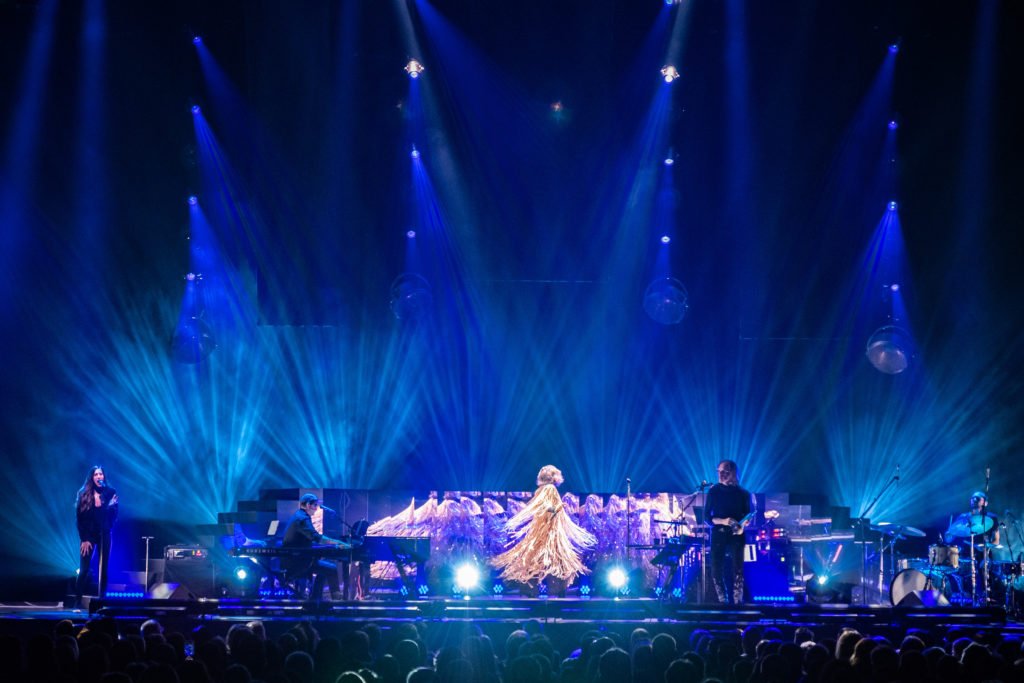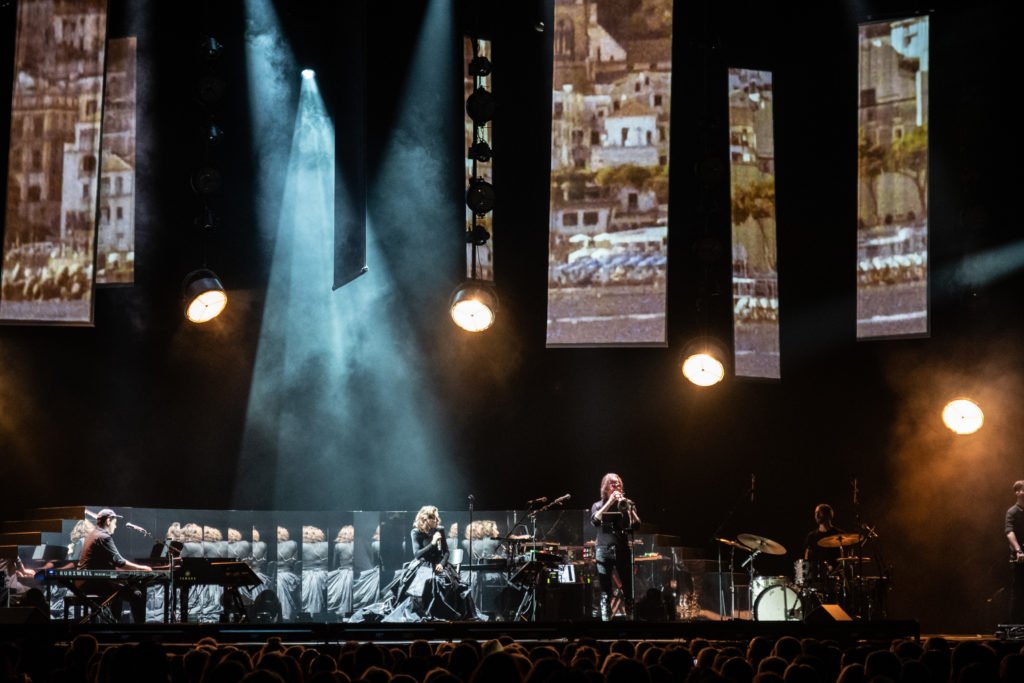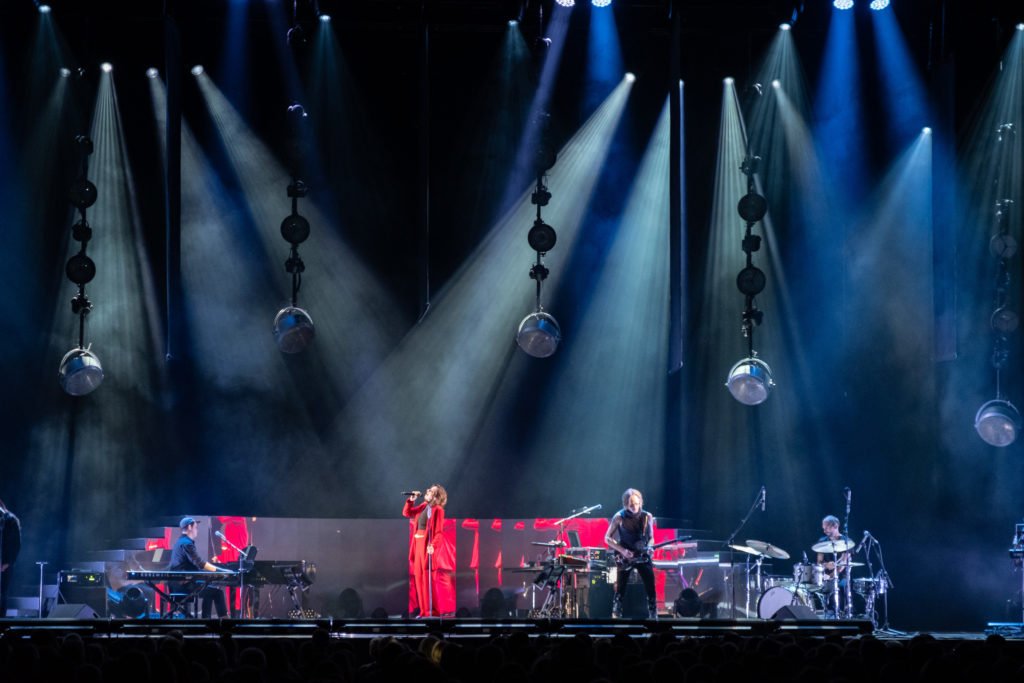News
22 Jul 2021
Tina Arena’s Enchanté 2021 Australian Tour
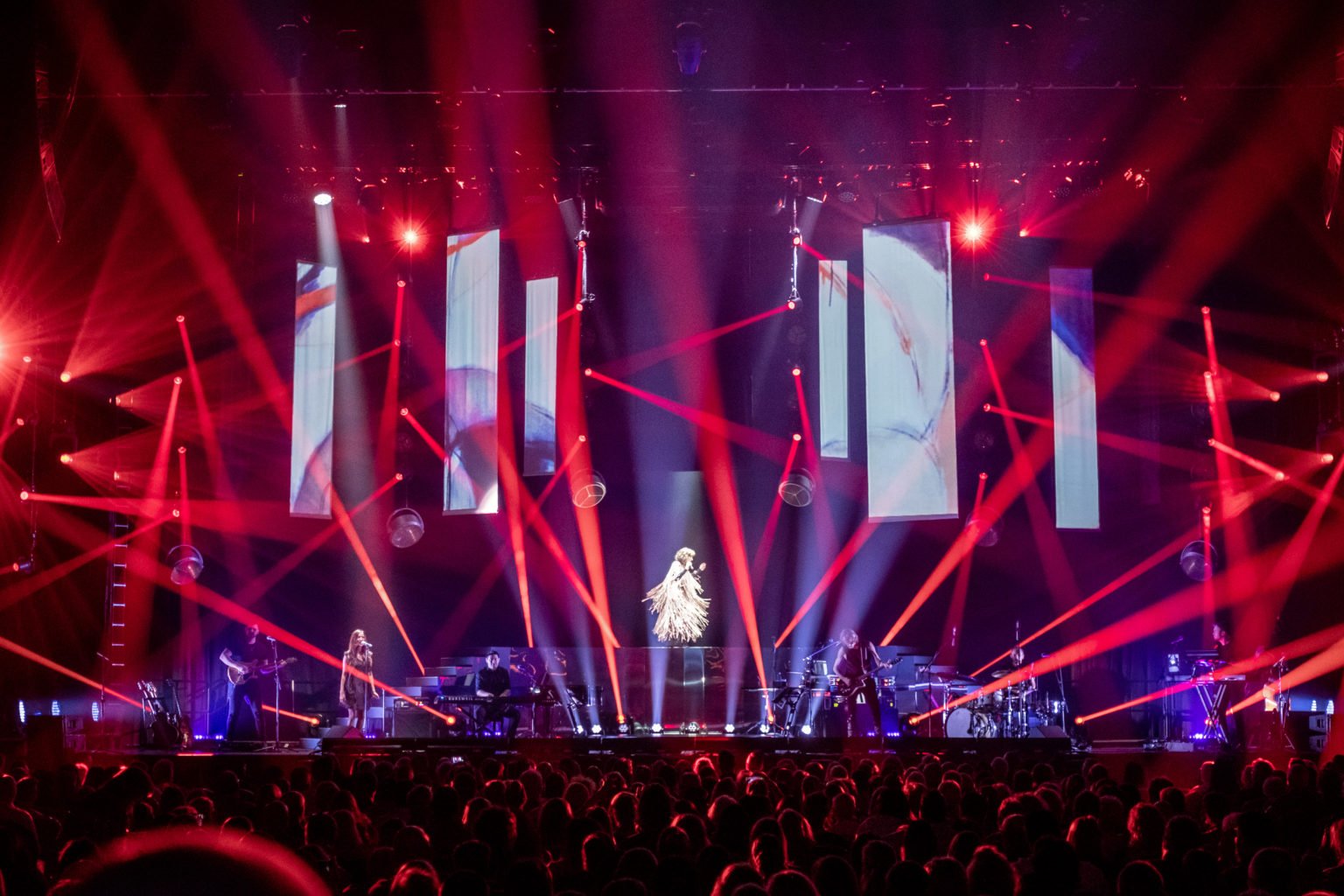
Subscribe to CX E-News
On Tuesday the 11th of May, the Tina Arena Enchante 2021 show rolled into the Adelaide Entertainment Centre for the South Australian leg of an eight city Australian tour.
I caught up with one of Australia’s highly respected sound engineers, Melbourne-based Danny Olesh, who was charged with delivering high-quality sound for the show.
The show carried multiple hangs of d&b audiotechnik KSL K8s, fed by an Avid S6L running Waves plugins at front of house, with another on monitors, both sharing a 64 input stage rack, all connected via AVB. The system was supplied by JPJ Audio.
The S6L at the monitor position was the master console on which all stage input gains were set. For the Adelaide show, a total of 56 audio channels were used from the stage, however, when groups and FX returns were added, the count totalled 72. For the Melbourne leg of the tour at the Sidney Myer Music Bowl, the channel count went up to 120-plus to cater for the Melbourne Symphony Orchestra. A separate console was used by John Hall to mix the Orchestra and the stems were sent to the FOH console for Danny to mix in with Tina and the band.
I had the opportunity to sit at Front of House during sound check and watch Danny weave his magic. Later, I witnessed the consummate professional that is Tina Arena perform many of her much-loved songs from her 20-year-plus catalogue.
Following sound check, Danny and I sat in the Entertainment Centre’s loading bay and discussed his career as a musician, electronics designer, software developer, studio owner, sound engineer, and production manager.
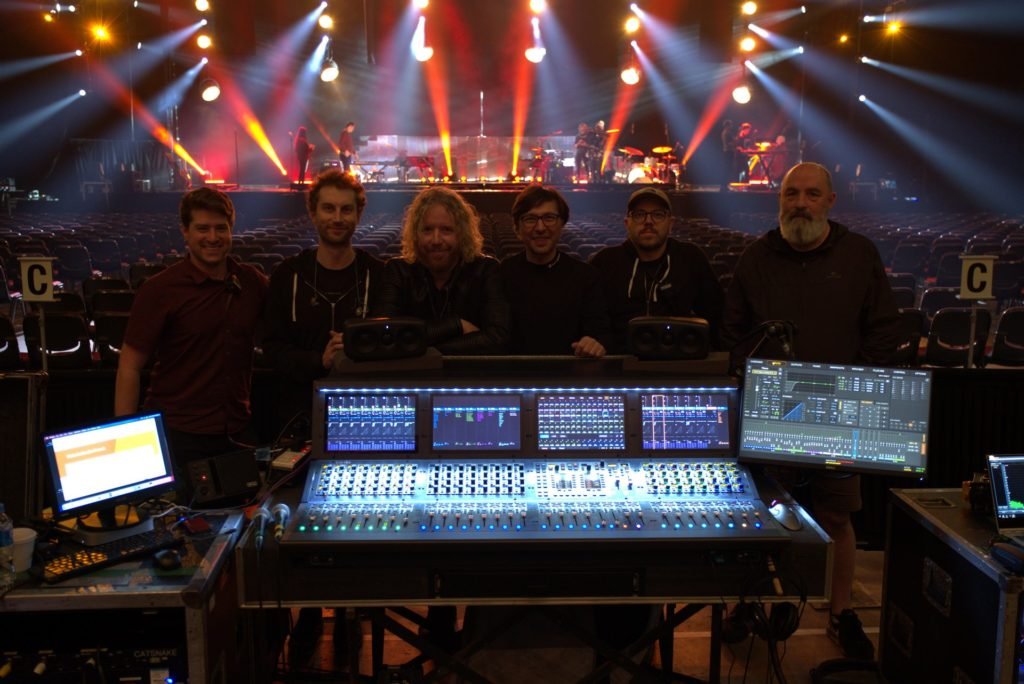
How many years have you been in the industry and how did you get started?
It’s been well over 40 years, and I have been pretty much involved in every facet of the music industry. My father played music and that led me to the electronics side of things, to computer engineering. I started playing music, used and learned a multitude of equipment, played keys and sang, and helped set up shows. I worked in recording studios, then owned a studio. I got involved in audio sales and retail management, started writing software, importing products and owning a distribution company.
I understand you also designed some equipment?
Our team created some real cool IP for digital mixing using HTML 5; the UI 16 and 24 which became so successful that we sold it to Harman. The original brand was SMPROAUDIO, and it became a Soundcraft product. It was an amazing learning experience.
I hear you recently have taken on a new role in the audio industry with a global audio company?
Yes, I am now working as the global CTO for Mackie International. The team at Mackie understand my love of the touring side of audio, and they have allowed me to continue to tour, as long as I can complete my tasks.
What are the most valuable lessons you have learnt about sound?
The first valuable lesson is to learn the music and genre you intend to mix inside and out. Have a good relationship with the artist, if you can, acknowledging that maybe sometimes it’s not possible especially when you do a walk-in mix for a band you don’t know. But the basics are still the basics and knowing a certain type (or types) of music will help you mix that style better.
Secondly, you need to learn to trust your ears and know where everything needs to be placed in a mix to create that space for the vocals. Mixing just instruments is easier, but when you have different vocals, and many of them, it’s a lot harder to get a really nice smooth band and vocal mix. It’s all about knowing the tricks to enable you to create that soundscape where everything is sitting in the right position.
Is it all about making space for that money-making channel like where to place Tina’s voice?
Yes, that correct, but I also hate harshness and I try and remove that as much as possible.
Who was your first mentor?
Bruce Johnson, the owner of JPJ Audio. He was mixing Oasis, Crowded House, Big Pig and many other big bands and used to mix our band in the 80s. I used to go and watch what he did. But much of my knowledge I gained through experimenting and listening to what other people were doing and trying things out for myself and listening back, perfecting my technique as much as I could in my own time.
You were mixing on analogue initially?
I was mixing mainly on analogue, and when digital came along, I wasn’t mixing at all in digital. I was designing software, I was in retail. I knew about digital consoles, I could build them, but I was not doing many shows. Then suddenly around 2016 I was doing shows and I was involved in a Prince tribute show. It was at that point I thought I’d better learn the larger digital consoles as well.
It was a right fit for me. I already had an intimate knowledge of plugins as the company I was involved with, Sound & Music, distributed the Waves suite of products, which I still use today.
So, from a mixing point of view, I knew what to use, how to use it and where to use it. Transferring that knowledge to the live scene was easy for me and really cool.
What was your first tour?
It would have been in 1994 or 1995 with Rick Price.
He actually had a duet with Tina Arena?
That’s right. Both Rick and Tina used to share the same manager. He is still active and sings very well.
Your favourite PA?
To be honest there are a lot of very good rigs around and it really depends on the system tech and system engineer and what they can achieve for the type of music and mix you are trying to recreate, as well as venue size requirements.
On this tour we are carrying multiple hangs of d&b audiotechnik KSL K8s and it is sounding fabulous. The system techs, Boden Birkett from JPJ Audio and John Hall, are great.
The last Guy Sebastian tour I did was in 2018 and I used the JBL A12s, which were also fantastic. I have used a lot of other brands that sounded good, but it does come down to the fact that if you have a good system tech who sets up the right amount of boxes in the room and it is designed and tuned properly, you can get the PA to sound beautiful.
I always have an idea of the sound I want to achieve, and I rely heavily upon the system techs. I play them what I want the sound to be like and that gives them something to work with to make the PA sound the way I want it to be.
What’s your favourite mixing console?
It’s difficult to say. I love using the Waves LV1 system if I am going to carry one around in my case. It sounds great, it is really compact, and I have used it on a few tours. I love using the Soundcraft Vi because the pre-amps are so warm, and the console has built-in Lexicon hardware processing. The reverbs sound gorgeous and lush; I used them on the last Tina tour.
Lately I am enjoying the Avid S6L, which sounds fantastic with all the plugins I want and need. The workflow is very similar to the Vi but the features and speed are a lot more current.
What are your favourite plugins?
I love the Waves F6 Floating-Band Dynamic EQ and C6 Multiband compressor. They are what I use the most across my groups and on some individual channels. Then there’s the H-Reverb and a plugin called Vitamin, which is a multiband sonic enhancer. I have an SSL compressor across the mix, SSL Channel on kick and snare and a lot of side band control from vocals to groups.
You don’t bring any speciality analogue gear with you on tour?
No, no need. I have all I need in the console and with Waves plugins.
How much pre-work have you put into this Tina Arena Australian tour?
We began with five days of band rehearsal, with full monitors, where I recorded multitracks, listened to them, and started to program the console. That was followed by two days of pre-production with full front of house mixing, and then finally one preview show before the tour.
Normally we would have a few extra days, but the tour schedule did not permit us to do any more.
The pre-work allowed me to listen to the songs probably 100 times or more to understand what every track is doing and what was needed for every song in Tina’s tour.
Moving onto the stage and your stage mic’ing. I spoke with your stage manager Jase who informed me that there are no backline amplifier cabinets at all, other than a sub for the double bass.
I wanted a quiet stage and I did not want any amplifiers onstage except for the bass player. He uses the sub to feel his double bass.
You didn’t have any trouble with the
double bass?
No trouble at all. It’s all a matter or tuning properly and notching out what gives you trouble. There is no need for plugins, just use the console parametric EQ. Each room is different and it’s a matter of using your double bass presets and tuning it to that room without removing the frequencies across the entire mix.
Blakely Maclean Davies is using a transducer and microphone combination on double bass, a DI on electric bass and two keyboards that go into a Helix processor to get that particular sound that suits each song.
Let’s move onto the violin, played by renowned composer, violinist and dancer Eric Avery who also opens for Tina. How is he mic’ed?
He is on a Barkus Berry transducer and DI, and the S6L and Waves plugins I use handle the violin very well without the inherent harshness.
Our Musical Director, Dorian West plays keys, guitars, lap steel and flugel horn and is simply mic’ed with a wireless Shure Beta 58. He also controls the backing tracks.
We also have Jake Earl also playing keyboards, and a superb sounding Yamaha Clavinova digital piano.
Tina’s drummer is Daniel Furrugia, a very tasteful player. He has a very old drum kit with thin skins, and I use mainly Shure and Sennheiser on the kit to make it sound smooth and full. I run the normal Beta91 for Kick in and a Beta52 for kick out, SM57 for top and bottom on snare 1 and snare 2, Shure condensers for hi hats and overheads, and Sennheiser 904s on the rack and floor tom.
We have the fabulous Nilusha Dassinakie on backing vocals, on lead guitars we have Emilio Kormanic, and there is also an entire team of creative talented people behind the scenes who have worked tirelessly to help present the best Tina Arena show possible.
Let’s talk about the money maker: Tina Arena’s microphone and channel processing.
I tried a few new capsules for Tina and Nilusha for the live shows and found the SE V7 capsule sounds marvellous and suits Tina’s voice the best. It gives her that breathy sound I need. The capsule has an exceptional super cardioid directional pattern and does not take in too much onstage sound.
For processing, I use snapshots to store different settings on the plugins, FX and EQ, depending on which song Tina is singing. I use the S6L on-board EQ, with a high pass filter, to notch out certain frequencies. It then igoes into a Waves C6 multi-band compressor to an F6 floating band dynamic EQ. It’s used for notching certain frequencies depending on the song dynamics. This changes within each song as well.
I follow up with a Waves De-esser, and then finally into a Waves plugin called Vitamin, a superb multiband sub harmonic and top end enhancer that just makes Tina’s voice sound so lush and beautiful without being harsh.
For FX I use the Waves H-Reverb with a De-esser to create a reverb with less sibilant sound. Again, depending on the song, a short or a long reverb. The long reverb is controlled by an aux send fader, not a return on the console, so I can allow the long reverb tail to finish nicely when nothing else is happening in the mix.
I also use chorus and delay on certain songs. All together I am using eight FX, long and short for vocals, specific reverbs for snare and toms, instruments reverbs, two delays and a doubler and chorus.
On monitor duties we have Ricki Rae on another Avid S6L console. He controls all the stage microphone gains and shares them with the FOH console via AVB. He also looks after the stereo Shure in-ears and stage processing for all the performers onstage. Ryan Fallis is there to help setup and take care of all the RF frequency coordination.
Do you use the sound check mode?
Absolutely. I arrive at the venue at least 4 ½ hours before the band and run through every multi-track in the set list to tune the PA. I find and deal with any problematic frequencies, and see how the room responds. Rickie also uses sound check mode and uses full cuff headphones as his cue to adjust all the onstage in-ears levels.
Are you using backing tracks?
Yes. They are controlled by our MD Dorian West. I have built a special rig for backing tracks that is also used for Icehouse and many other bands. It consists of two Cymatic uTrack 24s in failover mode via a Radial switching DI in redundant mode.
What are some of the most important things you setup when you turn up to a show?
It depends on the show and the location. In an arena, the system techs have already hung and tuned the array to the venue. I tend not to use Smaart as such. I leave it up to Boden and John who are the experts in arrays and processing. They know what I like and they try to achieve that soundscape.
They are tasked with aligning the arrays in the venue using the d&b NoizCalc and ArrayCalc software to achieve good base line audio. I listen to the PA, playing some multitracks, and I do a little more notching via the Waves Q10 parametric EQ. If harshness comes into it at certain volumes, then I will put an F6 dynamic EQ on it as well, and then the SSL compressor on my console output. We all discuss the overall sound and listen to a few more multitracks until I am happy with the overall sound, ensuring the vocals are sitting nicely. All the while I’m taking into consideration an empty venue, as we try and envision what will happen to the sound once the audience arrives.
For smaller shows, I do use Smaart for aligning speaker arrays and delays to get what I want out of the PA.
Has the audio Industry changed much in your lifetime?
Definitely. The quality and sound of the rigs just keeps getting better, as well as the tools and functionality that are available to help you achieve the result you want from your PA. I know many people have these nostalgic feelings about how things were, but the technology in speakers these days has come a long way.
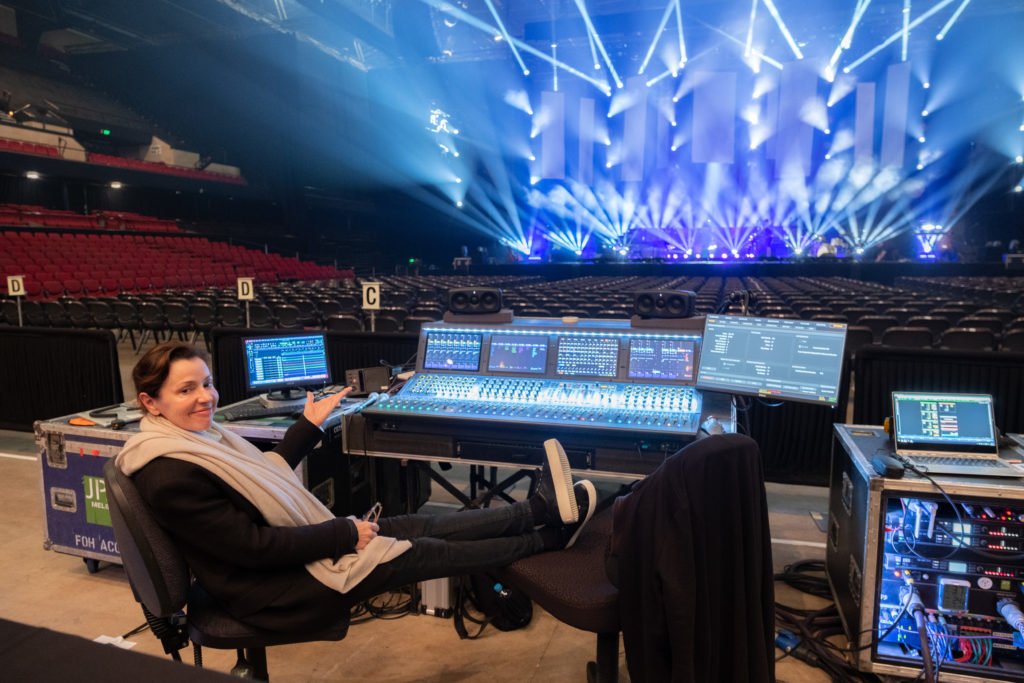
Subscribe
Published monthly since 1991, our famous AV industry magazine is free for download or pay for print. Subscribers also receive CX News, our free weekly email with the latest industry news and jobs.

